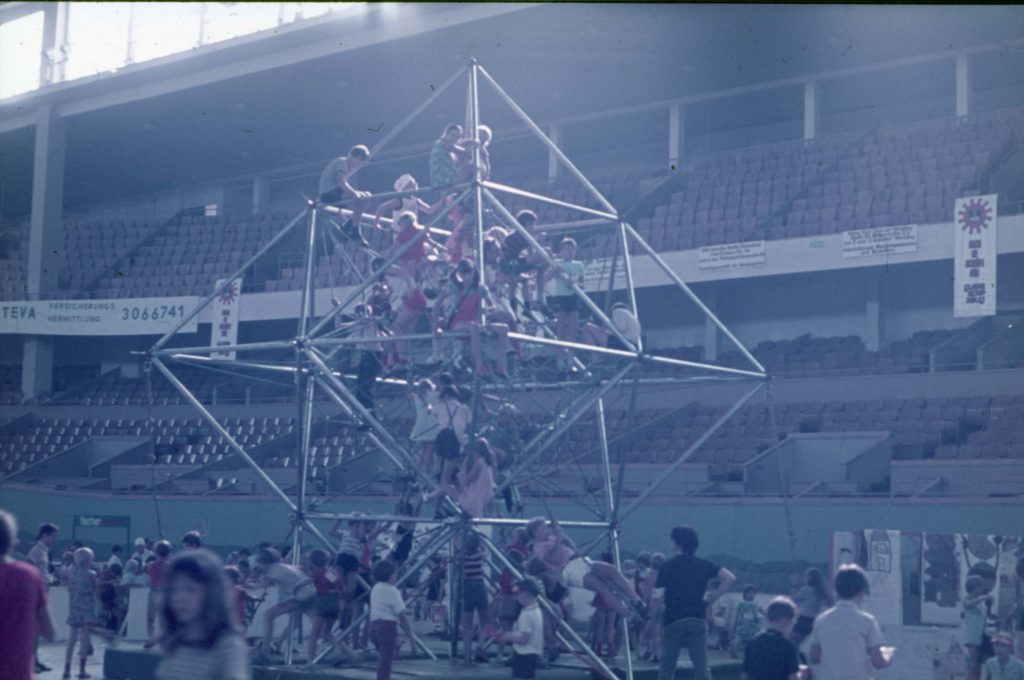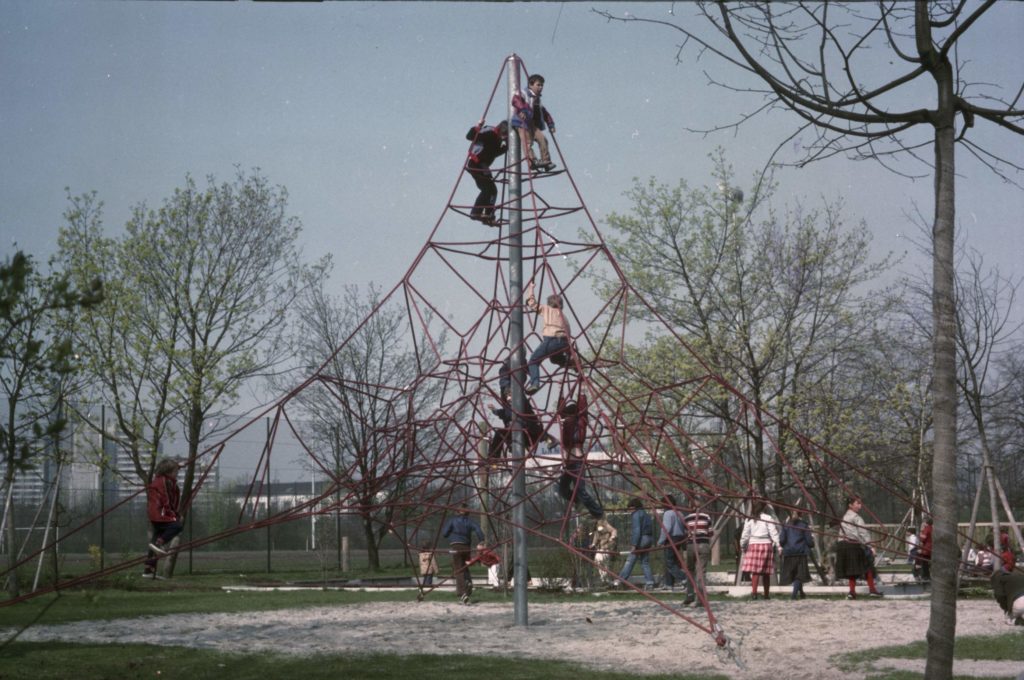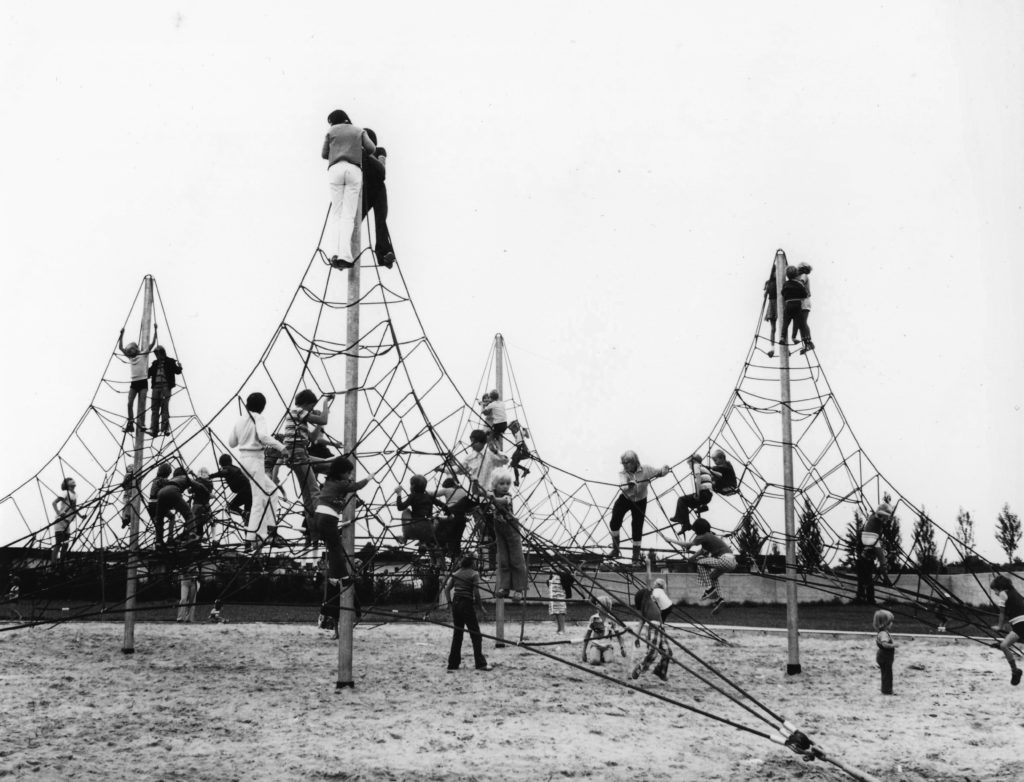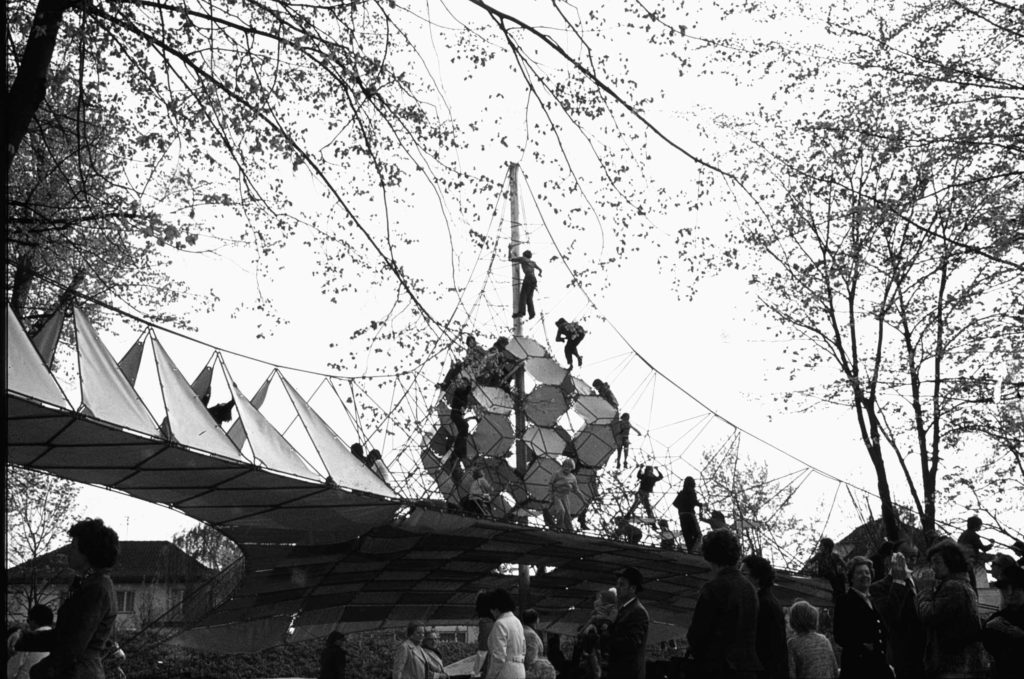Conrad Roland, 1934-2020, Architekt
Conrad Roland (Geburtsname: Konrad Otto Roland Lehmann) absolviert eine Tischlerlehre, bevor er 1959 das Architekturstudium abschließt. Für kurze Zeit arbeitet er beim bekannten Architekten Frei Otto. Ab 1961 beginnt Roland sich vertieft mit Hängehäusern und Raumnetzen auseinanderzusetzen. Er veröffentlicht 1965 eine wegweisende Monographie über Frei Ottos Leichtbauweise. 1967 baut er erstmals ein Raumnetz aus Stahlseilen, im gleichen Jahr erregt der von Frei Otto erbaute Pavillon in Leichtbauweise bei der Expo in Montréal großes Aufsehen.
1970 versucht Roland erstmals Raumnetze als Geräte für Kinderspielplätze zu konzipieren. Für die Kinderparty auf der Messe Berlin 1971 entwirft er das Riesen-Oktanetz, ein „sieben Meter hohes Spiel-Hochhaus“, welches den Bundespreis Gute Form 71 erhält. Es sind futuristisch anmutende Spinnennetze, auf welchen viele Kinder gleichzeitig und ohne ihre Eltern in alle Richtungen herumturnen und klettern können. Roland beschreibt den Vorteil des Raumnetzes gegenüber herkömmlichen Spielgeräten mit folgenden Worten: „Wo kein Platz ist, in die Luft ausweichen, neuen Spiel-Raum durch Raum-Netze schaffen“.
Entstehen die Raumnetze zuerst in seiner Wohnung und im Garten, gehen sie 1972 in der Berliner Seilfabrik in serielle Produktion. In zahlreichen Ländern durch Patente geschützt, entwickelt Roland die Idee des Spielraumnetzes in unzähligen Varianten weiter. Sind die Raumnetze vorerst an Gerüsten aus Aluminiumrohren aufgespannt, so entstehen ab 1973 mit dem Seilzirkus Netzstrukturen, die an Mastrohren hängen. Die feste Verankerung erlaubt es, Seilzirkusse bis zu 14 m Höhe zu bauen. Ein monumentaler Dreimast-Seilzirkus steht auf der IGA (Internationale Gartenausstellung) in Hamburg und auf der IGA Mannheim. Es folgt die Gründung von „Spielbau Conrad Roland“ (später Corocord GmbH) in Berlin, welche Hunderte von Netzstrukturen in aller Welt installiert. 1985 verkauft Roland sämtliche Firmen, Patente und Urheberrechte und zieht später nach Hawaii.
Conrad Roland, 1934-2020, architect
Conrad Roland (born: Konrad Otto Roland Lehmann) trained as a carpenter before graduating in architecture in 1959. For a short while he worked for the renowned architect Frei Otto. From 1961 onwards Roland started focusing on suspend houses and spatial nets. In 1965 he published a pioneering monograph on Frei Otto’s lightweight construction method. Two years later he built his first spatial net made of steel ropes and that same year Frei Otto’s pavilion with its lightweight construction caused a real stir at the Expo in Montréal, Canada.
In 1970 Roland first tries using spatial nets as equipment in children’s playgrounds. For the Kid’s Party at the Berlin Trade Fair 1971 he designed a huge Octa-Net, a “seven-meter-high play high-rise” that promptly won the Federal Prize for Good Form 71. It consists of somehow futuristic spider’s webs on which many children can play about and climb in any direction – without their parents needing to be present. Roland described the advantage of a spatial net compared to the customary play equipment as follows: “Where there is no space you can head for the air, creating new play spaces by spatial nets.”
While the spatial nets were initially made in his apartment and garden, in 1972 they went into mass production in Berliner Seilfabrik. Patent-protected in numerous countries, Roland developed the idea of the play space net in constant other versions. While the spatial nets are originally bound to frames made of aluminum tubing, from 1973 onwards with his Rope Circus he started making net structures that hung from masts. The fixed anchoring enabled such rope circuses to rise to up to 14 meters high. One monumental threemast rope circus stands at the IGA (International Garden Show) grounds in Hamburg and another on IGA Mannheim. Before long, he founded “Spielbau Conrad Roland” (later Corocord GmbH) in Berlin, which installed hundreds of net structures the world over. In 1985 Roland sold all the companies, patents and copyrights and later moved to Hawaii.
©Gabriela Burkhalter / December 12, 2019



